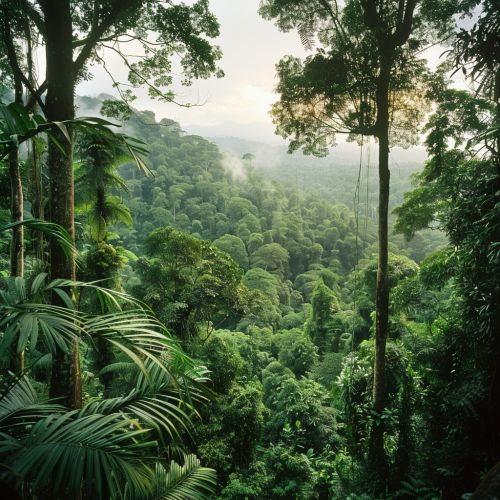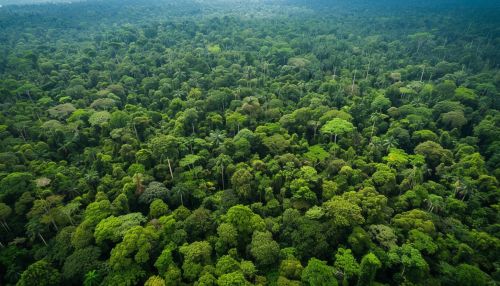Borneo
Geography
Borneo is the third-largest island in the world and the largest in Asia. It is located in Southeast Asia and is divided among three countries: Indonesia, Malaysia, and Brunei. The island is situated north of Java, west of Sulawesi, and east of Sumatra. Borneo's geographical coordinates are approximately 0°N 114°E.


The island covers an area of about 748,168 square kilometers. The Indonesian portion of Borneo is known as Kalimantan, which makes up about 73% of the island. The Malaysian states of Sabah and Sarawak occupy about 26% of the island, while the tiny nation of Brunei occupies the remaining 1%.
Topography
Borneo's topography is characterized by rugged mountains, extensive river systems, and dense rainforests. The highest peak on the island is Mount Kinabalu, which stands at 4,095 meters and is located in Sabah, Malaysia. The island's interior is dominated by a central mountain range that runs from the northeast to the southwest.
The island's river systems are extensive, with the Kapuas River in Indonesia being the longest, stretching over 1,143 kilometers. Other significant rivers include the Rajang River in Sarawak and the Barito River in Kalimantan.
Climate
Borneo has a tropical rainforest climate, characterized by high humidity, heavy rainfall, and consistently warm temperatures throughout the year. The island experiences two main seasons: the wet season and the dry season. The wet season typically occurs from November to March, while the dry season spans from April to October.
The island's climate supports one of the oldest and most diverse rainforests in the world, which is home to a wide variety of flora and fauna. The rainforest is a critical component of the island's ecosystem, playing a significant role in carbon sequestration and climate regulation.
Biodiversity
Borneo is renowned for its rich biodiversity and is considered one of the world's biodiversity hotspots. The island's rainforests are home to an estimated 15,000 plant species, 3,000 tree species, and numerous animal species, many of which are endemic to the island.
Flora
The flora of Borneo includes a wide variety of plant species, ranging from towering dipterocarp trees to unique orchids and carnivorous plants. The island is particularly famous for its dipterocarp forests, which are among the tallest and most diverse in the world. These forests are dominated by trees from the Dipterocarpaceae family, which can reach heights of over 80 meters.
Borneo is also home to several unique plant species, such as the Rafflesia arnoldii, which produces the largest flower in the world, and the Nepenthes rajah, a carnivorous pitcher plant.
Fauna
The fauna of Borneo is equally diverse, with numerous species of mammals, birds, reptiles, and amphibians. The island is home to several iconic species, including the Bornean orangutan, the pygmy elephant, and the proboscis monkey. The Bornean orangutan is one of the island's most famous inhabitants and is critically endangered due to habitat loss and poaching.
Borneo's rainforests also support a wide variety of bird species, including hornbills, pheasants, and the endangered Bornean ground cuckoo. The island's rivers and wetlands are home to several species of freshwater fish, amphibians, and reptiles, including the saltwater crocodile and the Bornean river turtle.
Human Geography
Borneo's human geography is as diverse as its natural environment. The island is home to a variety of ethnic groups, each with its own unique culture, language, and traditions. The largest ethnic groups on the island are the Dayak, the Malay, and the Chinese.
Dayak
The Dayak are the indigenous people of Borneo and are divided into several subgroups, each with its own distinct culture and language. The Dayak are traditionally hunter-gatherers and farmers, living in longhouses along the island's rivers. They are known for their rich cultural heritage, including traditional music, dance, and crafts.
Malay
The Malay people are predominantly found in the coastal regions of Borneo and are primarily involved in fishing, trade, and agriculture. The Malay culture is heavily influenced by Islam, which is the predominant religion among the Malay population.
Chinese
The Chinese community in Borneo is primarily involved in trade and commerce. They are concentrated in the urban areas of the island, particularly in the cities of Kuching, Kota Kinabalu, and Pontianak. The Chinese community has a significant influence on the island's economy and culture.
Economy
Borneo's economy is diverse, with significant contributions from agriculture, forestry, mining, and tourism. The island is rich in natural resources, including oil, natural gas, timber, and minerals.
Agriculture
Agriculture is a major economic activity in Borneo, with the cultivation of oil palm, rubber, and cocoa being the primary agricultural products. The island is one of the world's largest producers of palm oil, which is a major export commodity. Other important agricultural products include rice, pepper, and tropical fruits.
Forestry
Forestry is another significant economic activity in Borneo, with the island's rainforests providing valuable timber and non-timber forest products. However, unsustainable logging practices have led to significant deforestation and environmental degradation, prompting efforts to promote sustainable forestry practices.
Mining
Borneo is rich in mineral resources, including coal, gold, and diamonds. The island's mining industry is a major contributor to the economy, particularly in the Indonesian region of Kalimantan. However, mining activities have also raised environmental concerns, particularly regarding water pollution and habitat destruction.
Tourism
Tourism is an increasingly important sector of Borneo's economy, with the island's natural beauty and rich cultural heritage attracting visitors from around the world. Key tourist attractions include Mount Kinabalu, the rainforests of Sabah and Sarawak, and the cultural festivals of the Dayak people.
Environmental Issues
Borneo faces several environmental challenges, primarily due to deforestation, habitat loss, and climate change. These issues have significant implications for the island's biodiversity and the livelihoods of its inhabitants.
Deforestation
Deforestation is one of the most pressing environmental issues in Borneo. The island has experienced significant forest loss due to logging, agricultural expansion, and infrastructure development. Deforestation has led to habitat loss for many of the island's unique species and has contributed to climate change by reducing the island's capacity for carbon sequestration.
Efforts to combat deforestation include the establishment of protected areas, reforestation projects, and the promotion of sustainable land-use practices. International organizations and local communities are working together to preserve Borneo's remaining forests and restore degraded landscapes.
Habitat Loss
Habitat loss is a major threat to Borneo's biodiversity. The island's rainforests are being cleared for agriculture, particularly for oil palm plantations, which has led to the displacement of many species. Habitat loss has particularly severe implications for large mammals, such as the Bornean orangutan and the pygmy elephant, which require large territories to survive.
Conservation efforts are focused on protecting critical habitats, establishing wildlife corridors, and promoting sustainable agricultural practices. These efforts aim to balance the needs of economic development with the preservation of the island's unique biodiversity.
Climate Change
Climate change poses a significant threat to Borneo's environment and its inhabitants. Rising temperatures, changing precipitation patterns, and increasing frequency of extreme weather events are impacting the island's ecosystems and human communities. Climate change is also exacerbating other environmental issues, such as deforestation and habitat loss.
Efforts to address climate change in Borneo include the promotion of renewable energy, reforestation projects, and the implementation of climate adaptation strategies. These efforts aim to reduce greenhouse gas emissions and enhance the island's resilience to the impacts of climate change.
History
Borneo has a rich and complex history, shaped by its strategic location and diverse cultures. The island has been inhabited for thousands of years, with evidence of human settlement dating back to the Paleolithic era.
Early History
The early history of Borneo is characterized by the development of complex societies and trade networks. The island's indigenous peoples, including the Dayak, developed sophisticated cultures and established trade links with neighboring regions. Borneo was an important center for the trade of valuable commodities, such as spices, gold, and forest products.
Colonial Era
The colonial era in Borneo began in the 16th century, with the arrival of European powers, including the Portuguese, Dutch, and British. The island was divided into several colonial territories, with the Dutch controlling the southern and central regions (Kalimantan) and the British controlling the northern regions (Sabah and Sarawak).
The colonial period had a significant impact on Borneo's political, economic, and social structures. The introduction of new technologies, crops, and administrative systems transformed the island's societies and economies. However, colonial rule also led to the exploitation of the island's resources and the marginalization of its indigenous peoples.
Independence and Modern Era
The modern era in Borneo began with the end of colonial rule and the emergence of independent nation-states. Indonesia gained independence from the Netherlands in 1949, and the regions of Kalimantan became part of the new Indonesian state. Malaysia was formed in 1963, incorporating the British territories of Sabah and Sarawak. Brunei, which had been a British protectorate, gained full independence in 1984.
In the post-independence period, Borneo has experienced significant economic development and social change. The island's natural resources have been a major driver of economic growth, but this has also led to environmental challenges and social tensions. Efforts to promote sustainable development and address environmental and social issues are ongoing.
Culture
Borneo's culture is as diverse as its population, with a rich tapestry of traditions, languages, and artistic expressions. The island's cultural heritage is shaped by its indigenous peoples, as well as the influences of Malay, Chinese, and European cultures.
Traditional Music and Dance
Traditional music and dance are important aspects of Borneo's cultural heritage. The Dayak people are known for their elaborate traditional dances, which are often performed during festivals and ceremonies. These dances are accompanied by traditional music, played on instruments such as the sape (a traditional lute) and the gong.
The Malay and Chinese communities also have rich musical traditions, with influences from Islamic and Chinese cultures. Traditional Malay music often features instruments such as the gamelan and the rebab, while Chinese music includes instruments such as the erhu and the pipa.
Crafts and Art
Borneo is renowned for its traditional crafts and art, which reflect the island's diverse cultural heritage. The Dayak are particularly known for their intricate beadwork, weaving, and woodcarving. Traditional Dayak textiles, known as pua kumbu, are woven using natural dyes and feature complex patterns and motifs.
The Malay and Chinese communities also have rich traditions of craftsmanship. Malay crafts include batik and songket weaving, while Chinese crafts include calligraphy and porcelain making.
Festivals
Festivals are an important part of Borneo's cultural life, providing opportunities for communities to come together and celebrate their heritage. One of the most significant festivals is the Gawai Dayak, celebrated by the Dayak people to mark the end of the harvest season. The festival features traditional music, dance, and feasting.
Other important festivals include Hari Raya Aidilfitri, celebrated by the Malay community to mark the end of Ramadan, and the Chinese New Year, celebrated by the Chinese community with lion dances, fireworks, and family gatherings.
